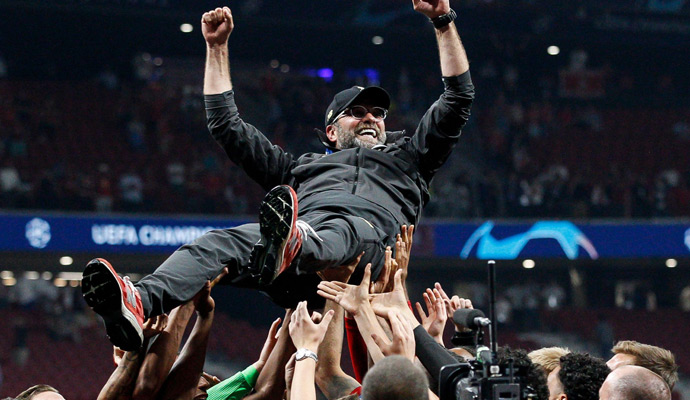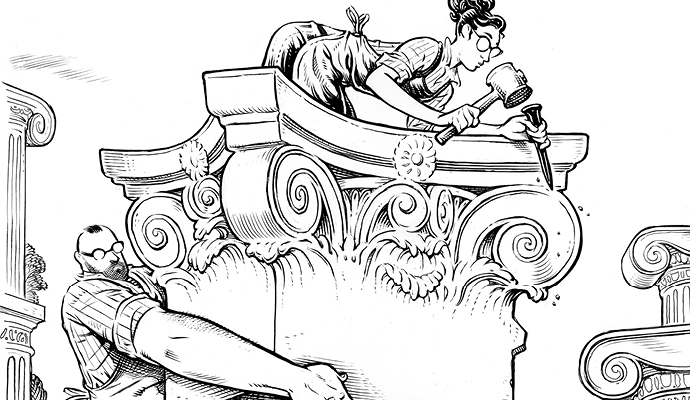Making It Easy to Do the Right Thing
In recovering from a crisis, ethical business practice and high performance aren’t opposed.
This article was adapted from a speech the author gave in January 2009 at a Carnegie Council for Ethics in International Affairs seminar entitled “Top Risks and Ethical Decisions.”
It’s 1953. You are a senior executive at a major manufacturer of a beloved product known for health, conviviality, sophistication, and glamour. Major parts of the economy in at least two states depend on this product, as do the livelihood of everyone you work with and the prosperity of your own family. Then a report comes across your desk that says this product is carcinogenic and addictive: It will hook people and kill them. What do you do?
The product, of course, is a cigarette, and executives of tobacco companies in the mid-1950s faced exactly this choice. Over the years, they would go on to explore a variety of options — marketing and advertising approaches, lobbying and legal strategies, and research aimed at finding less harmful cigarettes — but in the end, their possible alternatives boiled down to only two: They could tell the truth to the world, or they could hide the evidence and hope for the best. Imagine yourself facing that kind of uncertainty; it might take 40 years or more for the real facts to come to light, but then again, it might be sooner or it might never happen.
Now consider the plight of an auditor at Arthur Andersen LLP for the Enron Corporation in 2000, an Army Corps of Engineers officer studying the levees in New Orleans in 2004, a funds manager selling derivatives (or Bernard Madoff investments) in 2007, or a peanut-processing company executive with a concern about salmonella contamination. In all these cases, and in many other less visible (but equally difficult) moral dilemmas, the decision to tell the truth or to bury it entails a huge amount of risk and soul-searching. Viewed in that way, what we call “ethics” is really a set of decisions about which risk is easier to sleep with at night: opening up about an uncertain situation or trying to hide the worst of it from yourself and everyone else.
The Organizational Issue
Most ethics debates leave it to the individual to make a choice, and the historical accounts tend to champion the truth-tellers. But what really happens is rarely that simple. In our world, because most major actions are taken by organizations, no decision maker stands alone in facing an ethical dilemma. Therefore, what sorts of features must we instill in a collective — a team, an organization, a nation, a culture, or a society — to make it easier for people to make the decision to tell the truth? What can we do, as a group, so we don’t have to rely on the ethical compass of individuals?
This problem is made much more difficult by the inherent nature of the choice, and particularly the way in which feedback from any decision is provided to the decision maker. For example, that cigarette executive might sincerely want to tell the truth. So he might start talking about that prospect to others within the company.
Instantly, he would learn that most people in the company don’t agree that going public is a viable option. Perhaps they are afraid to risk their careers by supporting something they think the boss doesn’t want to hear. Perhaps they have an argument to make against telling the truth publicly. Or perhaps the idea is so unthinkable, they simply shut down any discussion. In any case, the feedback is immediate and flat-out negative.
A persistent executive might, in time-honored corporate fashion, propose a solution while raising the problem. The proposed fix might be to market a “safer” cigarette, as many companies tried with filtered cigarettes in later years. But to test this solution, you have to introduce it in the market. It will take two or three years to learn whether it will be a success, and you might find, as McDonald’s found with its failed McLean burger, that the virtuous path is too unpopular to be successful.
Finally, you could seek more substantial proof. And it could take a generation to find out, through epidemiological surveys, whether your product really is addictive and carcinogenic. Even then, it may be almost impossible to separate cigarettes from all other potential causal factors. As with lead in the Roman Empire (or with cell phone radiation, painted toys, and other potential health risks today), only hindsight will reveal the extent of the problem. You don’t yet have the requisite information to make an appropriate decision.
Three Traits That Foster Ethical Behavior
Unfortunately, most organizations are not set up to help managers overcome this pressure. But some companies have a better track record than others, and their ability to support ethical behavior seems to depend on three characteristics that many organizations lack. Arguably, without these three qualities, companies of all stripes will continue to execute immoral actions that in many cases endanger society around them. And yet, in themselves, these qualities don’t have much to do with ethics per se. They are simply hallmarks of good business practice.
• Consciousness. This is also known as ingrained awareness of the ramifications of collective action. The Toyota Motor Corporation offers one of the great corporate examples of consciousness. Early in its existence, the company had a chief engineer, Taichi Ohno, who famously drew a chalk circle on the floor and asked newly hired engineers to stand within it for hours, watching the assembly line at work. Then Ohno would return and ask, “What do you see?” It was a first lesson in becoming continually alert to what was going on around them. Similarly, the well-known andon cord — the cord that any employee can pull to stop the assembly line if there’s a problem — is testament to the amount of consciousness people are expected to bring to work. Each individual is continually looking at the vehicles going by, judging whether they are flawed or whether they fit the customer’s mandate.
Some companies respond to ethical risk by instilling corporate responsibility. But without deliberately expanding people’s consciousness of their day-to-day work, these efforts tend to falter. People may go through the motions, but they don’t really see how their own actions further the lofty ideals of the initiative. Conversely, when individuals are conscious of how their own actions affect the company’s overall performance, ethical behavior is more likely to be the outcome, even if it isn’t articulated that way.
• Discipline. Neuroscience research over the last decade has demonstrated that continual, intensive focus changes the pattern of neurons within the human brain. If you want to alter an organization, the way to do it is not to lecture people about the “burning platform” — the organizational problems that must be addressed immediately — but to set up practices and processes that literally force people to do things in a different way day after day after day. Gradually, employees’ neurons change, so that eventually making more thoughtful, long-range-oriented decisions becomes second nature.
One organization that relies on discipline is SRC Holdings, a group of employee-owned remanufacturing companies in Springfield, Mo. Once a week, most of the SRC businesses shut down operations during lunch, and everyone, from the CEO to the maintenance worker, goes over the financial numbers: What are the costs and revenues this week, in what direction are profit margins going, how is the cash flow, and what can be done better right now? Everyone is expected to participate in the discussion. Over the years, SRC has spun out more than 30 long-lived businesses, nearly all instigated by its employees, precisely because the organization’s discipline fosters a combined business and ethical acumen.
• Empathy. When a company is truly empathetic, the recognition of the value of employees is just a starting point. A more critical factor is the continued high level of engagement with them, so that everyone in the organization is joined together, feeling a common imperative to do the right thing and make the right decisions. Cultivation of better relationships among different parts of the company (and with outsiders) becomes a paramount value.
Procter & Gamble Company, under its current CEO, A.G. Lafley, is famous for this. When Lafley became CEO, he removed the oak-paneled executive offices on the 11th floor of P&G’s Cincinnati headquarters and loaned the paintings that hung there to a local museum, according to the magazine of his alma mater, Hamilton College. He moved the divisional presidents’ offices nearer those of their staffs and converted the former executive space to an employee learning center. He did it, Lafley said, “So people understand we’re in the business of leading change.” He then instituted a policy of regular and frequent communication with staff, customers, suppliers, innovators around the world, and even competitors. In this environment, the fear of speaking out for the organization’s good diminishes; people feel not just invited, but compelled, to raise opportunities to improve.
Although these three factors are often linked to high performance, they are all too rare. They still feel counterintuitive in many corporate cultures. But now, in the face of extraordinary challenges, they’re more critical than ever. At heart, the distinctive edge of an “ethical” company, its means of survival when facing the challenges of a more transparent world, may come down to this: having enough consciousness, discipline, and empathy to instill a set of behaviors that make it easier for everyone to do the right thing. Some companies have already grasped the idea that ethical practice and high-quality business practice are one and the same. Let’s hope that idea, in time, will expand to more companies, and ultimately to the culture at large.![]()
Art Kleiner is editor-in-chief of strategy+business magazine and the author of The Age of Heretics, 2nd ed. (Jossey-Bass, 2008).



